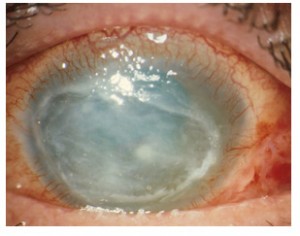Acanthamoeba, free-living amoebae found in air, dust, soil and water, are the main aetiological agents of a corneal infection known as Acanthamoeba keratitis (Acanthamoeba keratitisAK). The researchers identified, based on morphology, 25 species of Acanthamoeba including A. castellanii e A. polyphaga are those most commonly isolated in keratitis. The organism can take 2 forms: in adverse living conditions, form a cyst about 10-30 microns that has no nutritional requirements and is resistant to extreme conditions temperature, pH, desiccation and chemicals, and is therefore difficult to eliminate; under favourable conditions, such as the presence of food (algae, bacteria, other protozoa and perhaps keratocytes in the cornea), it takes the form of trophozoite, 20-50 microns in size, motile and more susceptible to eradication.

The Acanthamoeba keratitis is widespread globally and is recognised as a serious eye infection whose reported cases increase year by year. Inappropriate use of contact lenses is the main risk factor (85% of cases), but cases of AK have also been reported in non-contact lens wearers. AK patients experience severe pain associated with photophobia, annular stromal infiltrate, ulcers and corneal abscesses. Given the aggressiveness of the infection, AK must be treated properly and in a timely manner to avoid the most serious consequence, which can be loss of vision. The infection is usually unilateral and progresses slowly from the epithelium to the stroma, but if the diagnosis is delayed and Acanthamoeba has already penetrated deeply into the corneal stroma, successful treatment becomes extremely difficult.
The incidence of AK increases significantly in the summer monthsThis is probably because the heat invites people to cool off in seaside areas. L'water, in fact, of whatever origin - pool, sea, river, lake, hot tub, tap - can be a first reservoir of micro-organismsand even if recreational water is treated with disinfectants, it is still not sterile and may contain, among other microorganisms, Acanthamoeba. Inadequate hygiene and improper use of contact lenses, such as washing them and their containers with tap water or wearing them while playing water sports and while showering, are therefore strong risk factors for the development of AK.
Despite the warnings of the American Food and Drug Administration (FDA) and the Centers for Disease Control and Prevention (CDC) on the risks of contact lens exposure to water, some manufacturers do not educate consumers properly and the use of tap water during cleaning and rinsing still remains common behaviour, so cases of AK do not tend to decrease.
A very recent article published in Cornea showed, among 1,056 soft contact lens wearers, a high level of exposure of contact lenses to water and also found a misperception among users about the risk of infection associated with these exposures. The study showed that 86% of contact lens wearers shower with their lenses and 62% swim while wearing them, 41% of men and 29% of women rinse their lenses with tap water. The 40% of contact lens wearers also routinely rinse the case in which they store their lenses with tap water and this was identified as a major source of AK risk, probably because Acanthamoeba can adhere to and grow in these cases. In any case, the study shows that the contact lens wearers interviewed did not perceive that their behaviour could pose a risk for the development of AK. Moreover, contact lens wearers tend to seek medical attention late, because they are accustomed to minor irritations of the eye, and this represents another risky behaviour given that early diagnosis of AK is crucial for the best resolution of the infection.
There are no approved drugs for the treatment of Acanthamoeba keratitis in any country in the world. Current treatment regimes usually include the use of a cationic antiseptic topical agent such as the polyhexamethylene biguanide (PHMB, 0.02%) or chlorhexidine (0.02%) with or without diamidine. The duration of therapy can vary from six months to one year. This therapy has shown good results in most patients and started early allows full visual recovery. However, a retrospective study conducted at Wills Eye Hospital (Philadelphia) found that in recent years, there has been an increase in the severity of AK associated with an increase in therapeutic failure. Precisely in response to the need for appropriate medical treatment, a European research project (ODAK, Orphan Drug for Acanthamoeba Keratitis) which aims to developing a stable and safe formulation of PHMB for the pharmacological treatment of AK, the project recently received approval from the UK regulatory authorities for the phase III clinical study.
Bibliography
- Lorenzo-Morales J et al. An update on Acanthamoeba keratitis: diagnosis, pathogenesis and treatment. Parasite. 2015; 22:10. doi: 10.1051/parasite/2015010.
-Zimmerman AB et al. Water Exposure is a Common Risk Behavior Among Soft and Gas-Permeable Contact Lens Wearers. Cornea. 2017 Apr 13. doi: 10.1097/ICO.0000000000001204.
-Siu S. Acanthamoeba keratitis: Are recent infections more severe? Presented at: Wills Eye Conference; March 9-11, 2017; Philadelphia.
Dr. Carmelo Chines
Direttore responsabile
